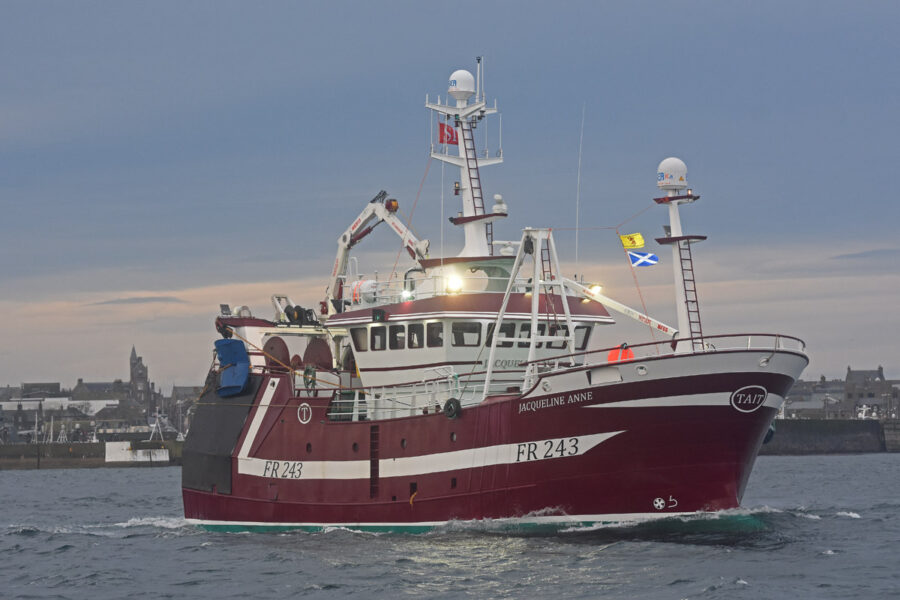Twin-rig trawler from Macduff Shipyards
A number of innovative features, most of which are relatively minor when viewed singly, have dovetailed into the overall design for maximum benefit on the new 24.5m Fraserburgh twin-rig trawler Jacqueline Anne FR 243, reports David Linkie

01 Jacqueline Anne off Fraserburgh.
That Jacqueline Anne breaks new ground for the prawn fleet is testament to the high degree of forward thinking and co-operation put into the new-build project by the owners – skipper Adam Tait and his sons, skippers Adam Jnr and Jonny Tait – and the boatyard.
One of the key reasons for this is undoubtedly the excellent working relationship that exists between the owners and builders. Repeat orders are always a sure sign of customer satisfaction, and the fact that Jacqueline Anne is the fourth new twin-rig trawler that Macduff Shipyards has handed over to the Tait family in 12 years says everything about build quality and the subsequent level of consistent fishing performance.
A few hours before Jacqueline Anne left Fraserburgh harbour to fish her maiden trip before Christmas, skipper Adam Tait said: “Macduff Shipyards has yet again done us proud and delivered in style – which from previous experience we knew it would. The levels of build quality, machinery installation and finish speak for themselves.
“Although the build programme was inevitably difficult due to Covid-19, the team have delivered a superb end result, albeit later than initially expected. This was outside their control because of government regulations, when all work had to stop in the early stages of the pandemic.

02 The Kumera K-CPP450 two-step 12.31 reduction gearbox, on which two load-sensing pumps are mounted.
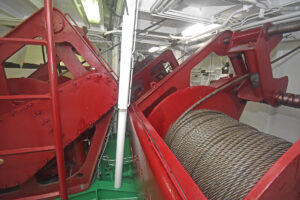
03 Three split trawl winches are positioned forward on the main deck.
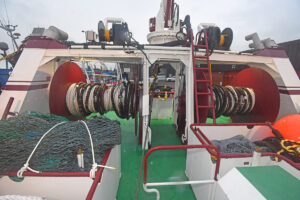
04 Sweepline and auxiliary winches are located aft on the shelterdeck.
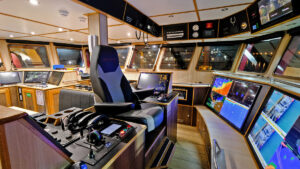
05 The wheelhouse interior.
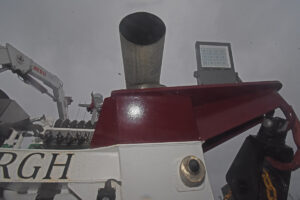
06 The engine exhausts exit through the legs of the trawl gantry.
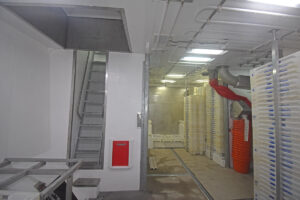
07 An easy-access fishroom ladder is arranged against the aft bulkhead of the ice locker.

08 Starboard quarter view of Jacqueline Anne.
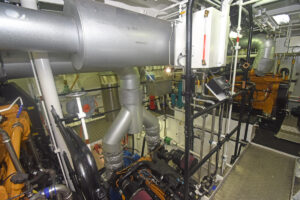
09 General view of the engineroom.
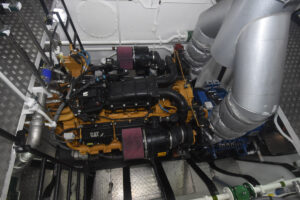
10 The Caterpillar C32 main engine.
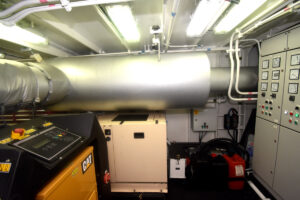
11 Large silencers routed upwards through the legs of the trawl gantry contribute to extremely low noise levels in the accommodation areas and wheelhouse.
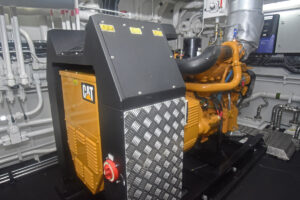
12 Two Caterpillar C7.1 gensets provide main electrical power on Jacqueline Anne.
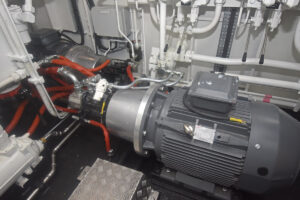
13 Two 45kVA power packs provide a gear-retrieve system…

14 …including the three split trawl winches.

15 Jacqueline Anne was built by Macduff Shipyards at Buckie.
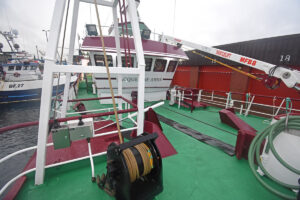
16 Arrangements atop the shelterdeck forward.

17 A middle rail provides additional safety by separating crewmen from the trawl wire and codend Gilson.
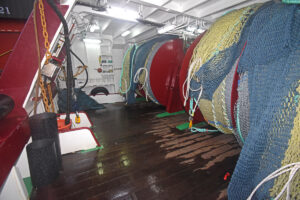
18 Two sets of 2 x 12t split net drums are mounted on the hardwood-decked quarter.
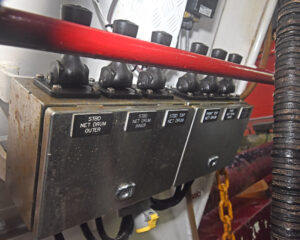
19 Control units for the net and sweep drums are centrally positioned between the two gear openings across the transom.
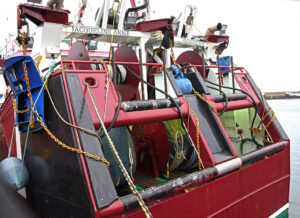
20 Stern view of working arrangements across the transom.
“Early indications are that the new ideas we’ve gone for this time round are working well and will prove beneficial in the long term.”
Insured by Sunderland Marine, Jacqueline Anne has the distinction of being the first new Scottish twin-rig prawn trawler to feature a variable-pitch propulsion system, chosen to give greater control of the initial bite associated with increasingly large-diameter propellors.
Accordingly, the deck machinery, which includes three split trawl winches housed in a dedicated compartment forward on the main deck, and two sweepline winches aft, is driven by two load-sensing pumps mounted on the main engine gearbox. The main hydraulic control valves are also fitted in the engineroom, thereby minimising the amount of pipework serving the deck machinery.
Running all engine exhausts inside the legs of the trawl gantry, offsetting the fishroom hatches to port, and positioning the washers and prawn dip tank in the middle of the catch-handling deck are among the other ideas designed to enhance crew comfort and working efficiency.
The benefits of these changes were immediately apparent on a quick-fire five-day maiden trip that yielded nearly 500 boxes evenly balanced between prawns and whitefish, during which skipper Adam Tait reported that he was ‘delighted’ with how Jacqueline Anne performed.
A heaped box of monkfish, put ashore a few days before Christmas for sale for charity, netted £900 from buyers on Fraserburgh fishmarket. The Scottish Fishermen’s Organisation (SFO), Jacqueline Anne’s prawn buyer, and the vessel’s agent donated a further £200 apiece to take the amount raised to £1,300, with the money being shared equally between the Fishermen’s Mission and the RNLI.
Working through Westward Fishing Company Ltd, Jacqueline Anne is expected to work six-day trips to the North Sea grounds before landing into Fraserburgh, where the vessel’s catches of prawns are processed by the SFO.
Adam Tait and his sons Adam Jnr and Jonny will skipper Jacqueline Anne on a rotational basis, together with their second trawler, the 24m Rebecca FR 143, which Macduff Shipyards delivered in June 2016.
With main dimensions of LOA 24.5m, registered length 22.78m, beam 7.60m, depth moulded 4.3m and draught 4.8m, the design of Jacqueline Anne was developed to reduce hull resistance and therefore improve fuel efficiency and running speed. CFD technology was used at the first stage to measure the resistance of the new hull against previous designs, and to identify areas where further improvements could be made. Following this, the hull form was finalised and faired virtually by Macduff Ship Design, which then produced a detailed set of kit construction plans. Macduff Ship Design also produced the stability data upon completion of the build.
The steel kit was cut in-house by Macduff Profilers, a division of the yard, and the vessel was fabricated between the yard’s two sites, with the steel modules being fabricated in Macduff and then shipped to Buckie where the hull was assembled, engineered and fully fitted, before the vessel carried out sea and fishing trials in the Moray Firth.
The hull of Jacqueline Anne is built completely from steel, apart from the wheelhouse and masts, and features a double-chine hull form, transom stern and soft-nose bulbous bow, which is faired gently into the main hull body. In broad terms, the layout of the Jacqueline Anne is largely similar to some of the other recent new builds produced by the yard. Below deck are situated the cabins, the engineroom, the fish hold and a large freshwater tank forward of the collision bulkhead. Above deck are the aft shelter, the galley/mess and side passage area, the catch-handling area, and then a winch room forward, where three split winches are sited.
However, the working deck has been significantly rearranged to suit the owners’ requirements and features a dry locker, hold unloading hatch, fishroom easy-access stairwell and refrigeration plant room all to the port side, which creates a large hatch-free fish-processing area on the vessel’s centreline, with the standard hopper and tray sorting arrangement on the starboard side.
The galley and mess area extend the full length of the deckhouse, which also includes a spacious central shower and washroom. The usual range of electrical units in the galley were supplied by RD Downie of Fraserburgh which, as customary with all Macduff builds, wired Jacqueline Anne and manufactured the engineroom and wheelhouse electrical distribution cabinet boards. The catch-handling deck amidships is connected to the quarter by a passageway aligned along the port side of the hull. The forward part of the passageway includes drying facilities for the crew’s deck gear, while the aft half features individual panelled lockers.
Eight single-level beds, effectively arranged into four two-berth cabins, are situated in the sleeping accommodation down the aft stair.
Engineroom
The degree to which the owners, in close liaison with the builders, have endeavoured to ensure that Jacqueline Anne will be an efficient and economical boat to operate in years to come is reflected in the choice of propulsion package, which breaks new ground for a twin-rig prawn trawler by featuring a 2,700mm-diameter controllable-pitch propeller, supplied by Helseth A/S, driven by a Kumera K-CPP-450 two-step gearbox with 12.3:1 reduction.
Propulsion power is provided by a Caterpillar C32 main engine developing 559kW @ 1,800rpm, supplied by Finning Power Systems, which is freshwater-cooled via a Blokland box cooler. The flexibility of the C32 main engine, which allows for full power to be developed between 1,600rpm and 1,800rpm, along with the unlimited control of pitch inherent in CPP systems, provides the vessel with a very large degree of control.
This was demonstrated on sea trials, where Jacqueline Anne excelled in control at low-speed operations, such as manoeuvring in the harbour, while also being able to optimise the engine rpm and propeller pitch combinations for both trawling and steaming to achieve maximum efficiency. An average top speed of 10.7 knots was recorded, while a more economical speed of 9.2 knots at 50% engine load was observed during steaming to the fishing grounds.
Primary hydraulic power is provided by two Danfoss load-sensing hydraulic pumps driven from the Kumera gearbox. A back-up hydraulic net-retrieve system is powered by two electrically driven pump sets, each of 45kW and capable of running simultaneously when both Caterpillar gensets are in use.
Electrical power onboard Jacqueline Anne is provided by two Caterpillar C7.1 generator sets, each with a rating of 118ekW and arranged for freshwater cooling via Blokland box coolers. The system is designed so that, if required, both generators can be run simultaneously, which gives the opportunity to power the vessel’s general systems and both the electrically driven hydraulic pump sets at the same time. A small Beta Marine harbour set of 33kVA rating is also fitted. This is contained within a silenced acoustic housing to reduce noise levels when the vessel is berthed.
The electrical systems onboard were designed and fitted by RD Downie, which also provided a large central switchboard along with all the pump and motor starters. In addition to this, RD Downie also provided the fire, bilge and gas alarm systems onboard, along with the navigation light panel, and assisted with the installation of the navigation equipment, which was supplied and commissioned by Woodsons.
A particular feature of the engine is the large silencers incorporated into the exhaust trunking leading to the aft corners, from where they are directed upwards to exit through the raked box-section legs of the trawl gantry.
The benefits of this new arrangement are twofold: more internal space in the galley/messdeck and the wheelhouse, and reduced noise levels. The latter was immediately obvious on fishing trials when, with the main and auxiliary engines running and the hydraulics clutched in, noise levels of below 60 decibels were recorded in the wheelhouse.
A triple rudder arrangement, which Macduff Shipyards has now fitted to a number of new builds, is positioned behind the propulsion nozzle. Providing greater steering thrust, the triple rudder means that considerably smaller degrees of helm are needed for course alterations. This results in less power loss when turning, so helping to maintain a vessel’s speed and reduce fuel usage. The benefits of triple rudders are particularly noticeable when towing across the tide. Having gained first-hand experience of the triple rudder on the previous Jacqueline Anne, and subsequently on Rebecca, the owners had no hesitation in opting for similar arrangements on the new Jacqueline Anne.
A hydraulically driven Kort bow thruster delivering 2,235kg of thrust is fitted for use when manoeuvring in restricted areas.
A double-bottom tank, wing tank and the daily service tank in the engineroom allow 26,258 litres of fuel to be carried. A large bulbous bow tank carries 19,199 litres of freshwater.
Customised trawling arrangements
Jacqueline Anne is equipped with a unique deck machinery package and load-sensing hydraulic system designed, manufactured and installed by Macduff Shipyards.
Three split trawl winches are positioned forward on the main deck in a separate winch room. Rated 15t core pull, the winches are fitted with Hagglund two-speed drive motors for faster hauling and shooting.
Spooled with 300 fathoms of 22mm-diameter fibre-core wire sourced from Caley Fisheries, Fraserburgh, the winches are arranged in a triangular formation, with the middle unit centrally positioned forward of the two outer winches.
Angled upwards from the drums at some 35º to hooded rollers, the outer wires run across the top of the shelterdeck to a second set of sheaves positioned near the forward corners of the wheelhouse, from where they are directed upwards and outwards towards hanging blocks mounted on a conventional trawl gantry. The sidewalks either side of the wheelhouse are effectively split into two by central safety rails, which ensure that crewmen are kept well clear of the trawl wires and codend Gilson when going forward to the bag hatch.
The middle wire runs under the wheelhouse floor, before leading upwards to a hanging block mounted on the underside of the base on which the powerblock crane is mounted, directly above a secure track for the safe storage of the middle roller.
The split trawl winches, together with all other deck machinery aft, are operated from a control panel built into the fishing console in the wheelhouse, from which the skippers have full sight of the trawl doors and clump coming up to the blocks.
Two 2 x 12t split net drums are arranged side by side on the non-watertight wooden-decked quarter, in line with the customary transom shooting and hauling hatches, the lower edges of which are fitted with free-turning large-diameter rollers.
Two sets of 2 x 8t split sweepline winches are mounted atop the shelterdeck in line with openings across the transom that extend down to the shelterdeck. Four x 60 fathoms of 34mm four-strand combination warp are worked over free-running rollers mounted aft of the customary drop-in guide-on pins.
Thistle Marine Ltd supplied the MKB13 kinked-boom crane, fitted with a slew-ring base and 24in powerblock, which is centrally fitted atop the middle wire gallows on the trawl gantry.
Two general-purpose 4.5t gear-handling winches are fitted on either side of the crane to give further options when working the twin-rig trawls.
The codends are taken aboard forward on the starboard side by a 5t Gilson winch serving a square-framed lifting gantry arranged over a hydraulically operated hatch and a large-capacity reception hopper.
A dedicated anchor Gilson is also fitted forward on the starboard side of the shelterdeck.
Catch-handling arrangements
The owners gave considerable thought to the catch-handling arrangements on the main deck, in order to minimise work and maximise catch quality.
While conventional in some aspects, the layout differs from the norm in that catches do not go towards the port side of the main deck. Rather, all washing and prawn-dipping activities are carried out on the vessel’s centreline in a natural forward progression.
This arrangement was made possible by moving the more usual centrally located fishroom hatch to the port side, aft of a walk-in compartment leading to an easy-access ladder down to the fishroom.
After being released from the codend into the reception hopper, catches are gravity-fed onto an elongated sorting table that extends aft. Standing with their backs against the starboard side of the boat, the crew sort and gut the catch off the table. Selections are placed into elevated baskets, while prawn tails are directed into baskets on the deck via separate chutes.
A large fish washer and two smaller prawn washers are positioned on the vessel’s centreline forward of the deck casing. On being released from the washers, baskets of prawns are then placed into one of four dip tanks, before being placed in secure deck racks for delivery to the fishroom.
The catch-handling area is kept free of excess water from the fish washers by two deck sumps drained by electrically driven Azcue pumps.
Capable of holding 450 stacker boxes in four tiers aft of the hatch, Jacqueline Anne’s fishroom has a working capacity of 700 boxes, supplied by GKN. Up to 6t of flake ice can be stored in a full-height locker on the port side, directly under a 2.5t Geneglace flake ice machine housed in the dedicated refrigeration plant room on the main deck.
In order to ensure that catches are landed in optimum condition, Premier Refrigeration Ltd of Fraserburgh fitted chilling to both the forward and aft bulkheads, as well as the deckhead.
The copper chilling pipes fitted to the vertical bulkheads are protected by stainless steel sheeting rather than the more generally used galvanised plates. Stainless steel 22mm-diameter piping is mounted on the deckhead.
Automatically controlled from the wheelhouse and set to the required temperature by a digital thermostat, the cooling plant comprises a Bock compressor, a Cleghorn Waring water pump driven by a three-phase electric motor and a Blitzer seawater condenser.
Prawns and whitefish are delivered to the starboard side of the fishroom via three dedicated chutes. Whitefish are stored in a selection hopper until being released for weighing and labelling using an VCU Catch Management system.
Catches are discharged from the fishroom using a radio remote-controlled Thistle MFB8 straight-boom crane fitted with a 1t landing winch.
Woodsons electronics in superbly finished wheelhouse
Jacqueline Anne features a beautifully crafted and spacious wheelhouse, in which full advantage has been taken of the total absence of engine exhaust boxing, which also enhances full 360º vision.
A single NorSap skipper’s chair is centrally positioned, flanked by two small island units on which the communications equipment, main radar controls and trackballs are arranged. A central desk area is arranged abaft the skipper’s seat.
The rectangular fishing console is positioned centrally to provide a commanding view of the gear-handling activities atop the shelterdeck, complemented further by an array of CCTV display screens.
A small sink served by a boiling-water tap lies to starboard, adjacent to the access door. The accommodation trap is arranged in the opposite corner.
Slimline steering consoles, on which the electronic Lyngaa Marine engine speed/propellor pitch, tiller steering and bow thruster controls are mounted, are located either side forward.
Woodsons supplied, installed and commissioned the comprehensive array of electronic equipment, including a quad-view video wall utilising three 49in 4K bridge monitors arranged across the front of the wheelhouse, on which all modes of fishing and navigation operations are shown in customised screen displays. Five Neovo X24 wide-screen displays are also fitted.
An iPad app enables the skippers to select the preferred screen arrangement for the prevailing mode of operation, including multi-screen viewing.
The level of finish in the wheelhouse, together with the other internal accommodation areas on Jacqueline Anne, showcases the extremely high standards of craftsmanship for which Macduff Shipyards is renowned.
Bottom-sounding duties on Jacqueline Anne are handled by a JRC JFC-180BB digital broadband colour sounder operating a combination of four user-set frequencies between 38kHz and 200kHz, as well as providing ground discrimination data output interfaced to the Olex plotter.
Details of the vessel’s location are processed by two Furuno GP39 GPS receivers, and heading is provided by a Comnav GPS gyrocompass. Positioning data received is interfaced to an Olex 3D seabed mapping system and a Sodena Easywin plotting system, which support tidal data, AIS and ARPA tracking.
The JRC JMA-5206 main radar is backed up by a JRC JMA-5410 unit. Both radars are interfaced to a Jotron Class A AIS transceiver and, with ARPA, provide tracking through the Olex and Sodena plotters.
Steering and navigation are taken care of by a Navitron NT921 MKII digital autopilot, with duplicate jog levers on the forward side consoles and aft at the trawling station.
Communications and safety equipment includes a JRC JSS-2150 MF/HF GMDSS SSB radio telephone, Sailor and Icom DSC VHFs, Entel HT649 GMDSS handheld VHF, and JRC Navtex receiver.
Woodsons also installed a comprehensive CCTV system deploying 25 HD cameras. Recorded images can be viewed at any time by the owners on their mobile phones or iPads, providing additional security when Jacqueline Anne is lying in harbour.
Jacqueline Anne is equipped with a Simrad PX twin-rig Geometry net-monitoring system to provide optimum levels of fishing efficiency, in terms of both gear spread and fuel economy. Information supplied by three Simrad PX sensors gives the skippers constantly updated information on the geometry of the gear and the height of the nets.
The system is the latest model of the one fitted on the new Rebecca in 2016, which skipper Adam Tait described as a ‘great system’.
Woodsons also supplied a VCU Catch Management and fish-weighing system.
Skipper Adam Tait spoke very highly of the service provided by Woodsons’ engineers, for whom nothing was a problem.

21 The anchor Gilson and anchor.
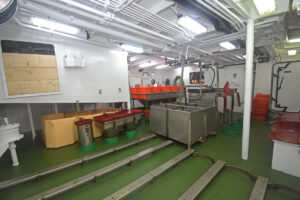
22 General arrangements on the new design of fish-handling deck.
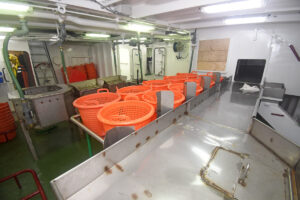
23 Catches are gravity-fed from the reception hopper onto an elongated sorting table.
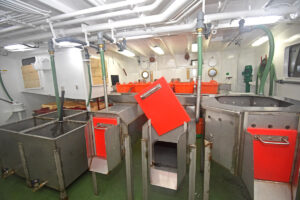
24 Central catch washers and prawn dip tanks.
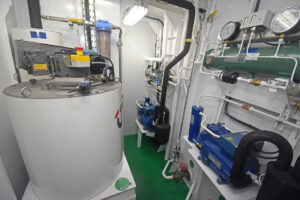
25 A 2.5t Geneglace flake ice machine and the fishroom chilling equipment are housed in a walk-in compartment forward on the port side of the main deck.

26 Looking to port across the aft section of Jacqueline Anne’s fishroom.

27 A VCU weighing and labelling system is located inboard of the fish locker on the starboard side of the fishroom.
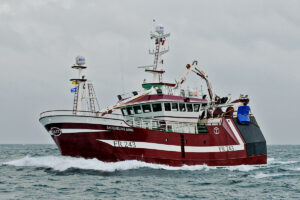
28 Jacqueline Anne returned an average top speed of 10.7 knots on engine trials.
Faithlie Trawl twin-rig prawn trawls
Having seen consistently successful results from similar designs of customised twin-rig prawn trawls on the previous Jacqueline Anne, as well as on Rebecca, Adam Tait had no hesitation in ordering two complete sets of gear from Fraserburgh netmaker Faithlie Trawl.
Jacqueline Anne’s bespoke fishing package includes a set of triple-mouth letterbox-style 200ft trawls rigged on 6in, 8in and 10in discs.
When towing for prawns on harder ground, Jacqueline Anne shoots 180ft ‘off-roader’ prawn scraper nets rigged on 8in and 10in discs.
Jacqueline Anne uses 50 fathoms of 34mm-diameter four-strand combination warp and 10 fathoms of 20mm-diameter wire rubber legs to connect the twin-rig trawls to a 1,200kg roller clump and a set of Thyborøn Type 11 72in trawl doors.
Caley Fisheries of Fraserburgh supplied all Jacqueline Anne’s trawl chandlery, including 3 x 300 fathoms of 22mm-diameter fibre-core trawl wire.
Tait family strengthens long association with Macduff Shipyards
Jacqueline Anne is the fourth new twin-rig trawler that skipper Adam Tait and his sons have taken delivery of from Macduff Shipyards in the past 12 years, highlighting the total loyalty that exists between the owners and builders.
The first, Rebecca FR 143, a 21.2m vessel, was handed over by Macduff Shipyards in December 2008. Named after skipper Adam Tait’s daughter, this vessel replaced a 21m wooden-hulled twin-rig trawler, built by Macduff Shipyards as Achieve BF 223 for Banff skipper James Pirie in 1995. Achieve was renamed Rebecca FR 143 in 2000 when Adam Tait replaced the 22.5m Astra FR 143, which he purchased from Buckie skipper Aaron Mair in 1990.
Astra (BCK 67) was built by George Thomson of Buckie in 1976 as a seine-netter for skipper William Fletcher of Portgordon who, after buying the Danish-built steel-hulled seiner Treasure INS 293 from Thomas Sutherland of Hopeman, sold Astra to Aaron Mair. After buying Astra, Adam Tait – who after sailing as mate on a purser, joined his father-in-law Alex Mitchell’s prawn trawler Jacquamar FR 95 – subsequently refurbished Astra extensively for twin-rig prawn trawling, including fitting a new wheelhouse, a three-quarter-length shelterdeck and a three-drum trawl winch.
Having started their fishing careers on the first Rebecca immediately after leaving school, Adam Tait’s sons Jonny and Adam developed their careers on the new family boat by getting their skipper’s tickets, before skippering Rebecca together alternately.
In 2013, the well-established and successful family business was consolidated when Macduff Shipyards delivered the 23m Jacqueline Anne FR 243, named after Adam Tait’s wife.
Three years later, the owners took delivery of the 24m Rebecca FR 143, shortly after her predecessor was bought by St Ives skippers David and Alec Stevens and renamed Crystal Sea SS 118. Twelve months ago, they took delivery of the new 24.5m Crystal Sea SS 118 from Macduff Shipyards, when the 2008-built Rebecca/Crystal Sea was bought by Leestlin Trawlers and renamed Vellee N 393.
Six months ago, the 2013-built Jacqueline Anne was bought by Macduff skipper William Runcie and renamed Ocean Challenge BF 85, replacing a 21.3m wooden-hulled twin-rig trawler of the same name – built by Macduff Shipyards in 2000 as Adele BF 36 – which was bought by the Heather Fishing Company and renamed Ocean Rose INS 115.
JACQUELINE ANNE FR 243
DETAILS
Owners: Adam, Adam Jnr and Jonny Tait, Fraserburgh
Designer/boatyard: Macduff Shipyards Ltd
Agent: Westward Fishing Ltd, Fraserburgh
DIMENSIONS and CAPACITIES
Length overall: 24.50m; Length reg: 22.78m; Beam: 7.6m; Depth moulded: 4.3m; Draught: 4.8m; Tonnage: 249t gross; Fuel: 26,258 litres; Freshwater: 19,199 litres; Lube oil: 600 litres; Hydraulic oil: 2,800 litres; Fishroom: 700 boxes; 6t of ice
ENGINEROOM
Main engine: Caterpillar C32 of 559kW @ 1,800rpm driving through a Kumera K-CPP-450 two-step gearbox with 12.31 reduction to a 2,700mm-diameter four-bladed controllable-pitch Helseth A/S propeller; Speed: 10.7 knots
Auxiliary engines: 2 x Caterpillar C7.1 generator sets rated 118ekW; Beta Marine 33kVA genset in silenced cabinet
Bow thruster: Kort Propulsion hydraulically driven 2,235kg thrust
Fuel/oil filters/separator: CC Jensen
Bilge and deck pumps: 4 x Bombas Azcue SA electrically driven
DECK MACHINERY
Suppliers: Macduff Shipyards Ltd and Thistle Marine Ltd, Peterhead
3 x split trawl winches 15t; 2 x split net drums, 2 x 12t; 2 x split sweep winches 8t; codend winch 5t; 2 x auxiliary gear-handling winches 4.5t; 1 x anchor windlass; Thistle MKB13 kinked-boom short-post crane SWL 1,600kg/5.5m and Thistle 24in tilt ribbed-head powerblock c/w auxiliary winch; Thistle MFB8 SWL 1,000kg/8m straight-boom landing crane c/w Thistle landing winch
FISH-HANDLING/FISHROOM
Fish-handling system: Macduff Shipyards Ltd; Fishroom chilling: Premier Refrigeration Ltd, Fraserburgh; Ice machine: Geneglace 2.5t/day – Premier Refrigeration Ltd
ELECTRONICS
Supplier: Woodsons of Aberdeen
Fish detection
JRC JFC-180BB digital broadband colour sounder 38kHz and 200kHz; Simrad PX twin-rig Geometry system
Navigation
JRC JMA-5206 and JRC JMA-5410 radars; 2 x Furuno GP39 GPS receivers; Olex 3D seabed mapping system and Sodena Easywin plotter; Navitron NT921 MkII autopilot; Comnav GPS gyrocompass; Ultrasonic wind speed and direction sensor
Communications
JRC JSS-2150 150W GMDSS MF/HF SSB; 2 x Sailor 6210 VHFs; Icom M330 DSC VHF; Entel HT649 GMDSS handheld VHF; Phontech 3100 five-way talkback system; JRC NCR 333 Navtex; Jotron Class A; Jotron TRON 60 GPS; VCU Catch Management and fish-weighing system; eSEA 60 satellite TV system; eSea 60Ka internet communications system; Woodsons CCTV system c/w 25 cameras
FISHING GEAR
Warp supplier: Caley Fisheries, Fraserburgh – 3 x 300 fathoms of 22mm-diameter fibre-core trawl wire; Net supplier: Faithlie Trawl, Fraserburgh – 2 x 200ft twin-rig triple-mouth letterbox prawn trawls rigged on 6, 8 and 10in discs; 2 x 180ft twin-rig off-roader prawn scraper nets rigged on 8in and 10in discs; Doors: Thyborøn Type 11 72in 850kg; Clump: Macduff Shipyards Ltd – 1,200kg roller
ACCOMMODATION
4 x two-berth cabins
GENERAL
Engine controls: Lyngaa Marine; Insurance: Sunderland Marine; Lifesaving appliances: Blue Anchor Fire and Safety Ltd, Fraserburgh; Paint: International Ltd; Steering: Scan Steering Aps; Wheelhouse seat: NorSap; Windows: HK van Wingerden & Zn BV, Holland

